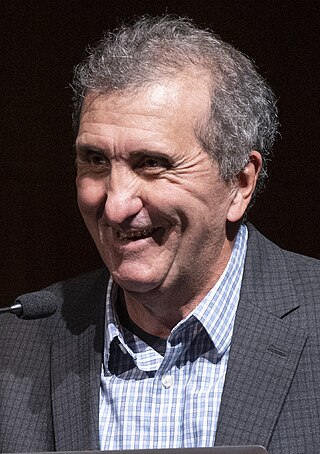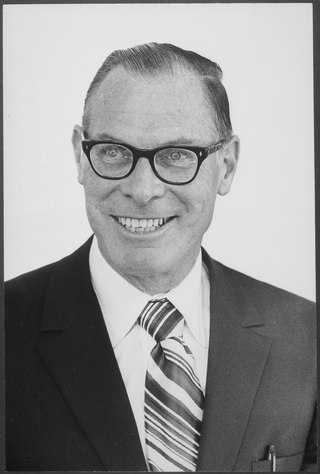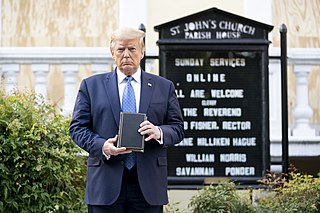
Richard Milhous Nixon was the 37th president of the United States from 1969 to 1974. A lawyer and member of the Republican Party, he previously served as a representative and senator from California and was the 36th vice president from 1953 to 1961 under President Dwight D. Eisenhower. His five years in the White House saw reduction of U.S. involvement in the Vietnam War, détente with the Soviet Union and China, the Apollo 11 Moon landing, and the establishment of the Environmental Protection Agency and Occupational Safety and Health Administration. Nixon's second term ended early when he became the only U.S. president to resign from office, as a result of the Watergate scandal.

A photographer is a person who makes photographs.

The White House press secretary is a senior White House official whose primary responsibility is to act as spokesperson for the executive branch of the United States federal government, especially with regard to the president, senior aides and executives, as well as government policies.

Ronald Louis Ziegler was the 13th White House Press Secretary and Assistant to the President, serving during United States President Richard Nixon's administration.

William Lewis Safire was an American author, columnist, journalist, and presidential speechwriter. He was a long-time syndicated political columnist for The New York Times and wrote the "On Language" column in The New York Times Magazine about popular etymology, new or unusual usages, and other language-related topics.

The Kitchen Debate was a series of impromptu exchanges through interpreters between U.S. Vice President Richard Nixon, then 46, and Chairman of the Council of Ministers Nikita Khrushchev, 65, at the opening of the American National Exhibition at Sokolniki Park in Moscow on July 24, 1959.

The nuclear football is a briefcase, the contents of which are to be used by the president of the United States to communicate and authorize a nuclear attack while away from fixed command centers, such as the White House Situation Room or the Presidential Emergency Operations Center. Functioning as a mobile hub in the strategic defense system of the United States, the football is carried by a military aide when the President is traveling.

David Hume Kennerly is an American photographer. He won the 1972 Pulitzer Prize for Feature Photography for his portfolio of photographs of the Vietnam War, Cambodia, East Pakistani refugees near Calcutta, and the Ali-Frazier fight in Madison Square Garden. He has photographed every American president since Lyndon B Johnson. He is the first presidential scholar at the University of Arizona.
"Mistakes were made" is an expression that is commonly used as a rhetorical device, whereby a speaker acknowledges that a situation was handled poorly or inappropriately but seeks to evade any direct admission or accusation of responsibility by not specifying the person who made the mistakes, nor any specific act that was a mistake. The acknowledgement of "mistakes" is framed in an abstract sense, with no direct reference to who made the mistakes, or the nature and extent of the mistakes. A less evasive construction might be along the lines of "I made mistakes" or "John Doe made mistakes"; a similar active existential construction might be "mistakes happened". The speaker neither accepts personal responsibility nor accuses anyone else. The word "mistakes" also does not imply intent.
Cover your ass, abbreviated CYA, is an activity done by an individual to protect themselves from possible subsequent criticism, legal penalties, or other repercussions, usually in a work-related or bureaucratic context. In one sense, it may be rightful steps to protect oneself properly while in a difficult situation, such as what steps to take to protect oneself after being fired. But, in a different sense, according to The New York Times' language expert William Safire, it describes "the bureaucratic technique of averting future accusations of policy error or wrongdoing by deflecting responsibility in advance". It often involves diffusing responsibility for one's actions as a form of insurance against possible future negative repercussions. It can denote a type of institutional risk-averse mentality which works against accountability and responsibility, often characterized by excessive paperwork and documentation, which can be harmful to the institution's overall effectiveness. The activity, sometimes seen as instinctive, is generally unnecessary towards accomplishing the goals of the organization, but helpful to protect a particular individual's career within it, and it can be seen as a type of institutional corruption working against individual initiative.

Peter Joseph Souza is an American photojournalist, the former chief official White House photographer for Presidents of the United States Ronald Reagan and Barack Obama and the former director of the White House Photography Office. He was a photographer with The Chicago Tribune, stationed at the Washington, D.C., bureau from 1998 to 2007; during this period he also followed the rise of then-Senator Obama to the presidency.

"Bring Us Together" was a political slogan popularized after the election of Republican candidate Richard Nixon as President of the United States in the 1968 election. The text was derived from a sign which 13-year-old Vicki Lynne Cole stated that she had carried at Nixon's rally in her hometown of Deshler, Ohio, during the campaign.
A press conference or news conference is a media event in which notable individuals or organizations invite journalists to hear them speak and ask questions. Press conferences are often held by politicians, corporations, non-governmental organizations, as well as organizers for newsworthy events.

The desk in the Vice President's Room of the United States Capitol, colloquially known as the Wilson desk and previously called the McKinley-Barkley desk, is a large mahogany partner's desk used by U.S. Presidents Richard Nixon and Gerald Ford in the Oval Office as their Oval Office desk. One of only six desks used by a President in the Oval Office, it was purchased in 1898 by Garret Augustus Hobart, the 24th Vice President of the United States, for the Vice President's Room in the United States Capitol.

Oliver F. Atkins was an American photographer who worked for the Saturday Evening Post and as personal photographer to President Richard Nixon.
The presidency of Richard Nixon began on January 20, 1969, when Richard Nixon was inaugurated as the 37th president of the United States, and ended on August 9, 1974, when, in the face of almost certain impeachment and removal from office, he resigned the presidency.

In the early hours of May 9, 1970, President Richard Nixon made an unplanned visit to the Lincoln Memorial where he spoke with anti-war protesters and students for almost two hours. The protesters were conducting a vigil in protest of Nixon's recent decision to expand the Vietnam War into Cambodia and the recent deaths of students in the Kent State shootings.

On June 1, 2020, amid the George Floyd protests in Washington, D.C., law enforcement officers used tear gas and other riot control tactics to forcefully clear peaceful protesters from Lafayette Square, creating a path for President Donald Trump and senior administration officials to walk from the White House to St. John's Episcopal Church. Trump held up a Bible and posed for a photo op in front of Ashburton House, which had been damaged by a fire during protests the night before.
James Kenneth Ward Atherton, was a press photographer active in Washington D.C. for over forty years.

The presidential transition of Richard Nixon began when he won the United States 1968 United States presidential election, becoming the president-elect, and ended when Nixon was inaugurated at noon EST on January 20, 1969. Nixon had become president-elect once the election results became clear on November 6, 1968, the day after the election. This was the first presidential transition to take place following the passage of the Presidential Transition Act of 1963.















